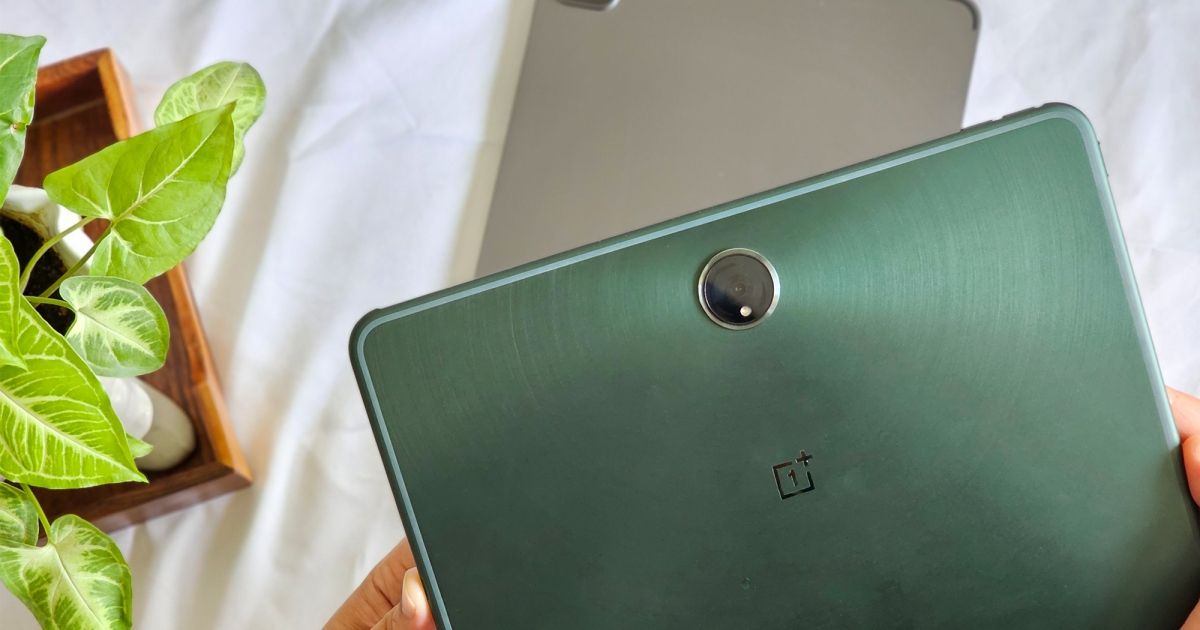I ditched my iPad Pro for an Android tablet - here's why
I work from home full time. That means distractions walk in freely, and keeping myself engaged is not always easy. In search of motivation, I lean toward change, novelty, and the urge to avoid being chained to my desk all day.
In this pursuit, the iPad Pro has proven to be a terrific gadget that allows me to get away from the clutter on my desk without giving up the capabilities of a computer. Being a Mac user, the iPad Pro easily fits into my workflow, primarily for seamless Continuity.
Recommended Videos
However, the OnePlus Pad has effortlessly made its way into my setup. Its similarities with the iPad allow me to use it interchangeably with the iPad Pro, but one (very tempting) feature makes me want to ditch my iPad: fast charging. It’s a seemingly small feature for the OnePlus Pad, but it’s been a game-changer in every sense of the word.
Similarities between the iPad and OnePlus Pad
Before I list why I find fast charging compelling, here’s what makes switching to the OnePlus Pad so much easier compared to any other Android tablet.
The OnePlus Pad takes on the 10th-Gen iPad and the 2022 iPad Air as its primary competitors. Since Apple’s stronghold in the market for premium and sub-premium tablets is difficult to overturn, OnePlus appears to have chosen a seemingly provocative way to get people’s attention.
While OnePlus phones can be visibly distinguished from the iPhone, the OnePlus Pad seems to mimic the iPad in many ways. Other than the intended utility of the two tablets, both have strikingly similar-looking displays with rounded corners, four speakers, identical button placements, and – not to forget — the resembling naming. Although the OnePlus Pad runs on OxygenOS 13 based on Android 13, you find key elements that set it apart from phones with the same software, including a persistent dock at the bottom, a circular cursor, and the ability to sync notifications, media, text messages, and calls with OnePlus smartphones automatically.
At the same time, it is also undeniable that the lack of a worthy competitor for the iPad leads to the parallels between it and the OnePlus Pad. The segment for Android tablets has felt desolate for some time while only being helmed by Samsung with its flagship Galaxy Tab S series — especially if we rule out Android tablets like the Xiaomi Pad 6 that aren’t available in the U.S.
Samsung’s Galaxy Tab S8 series offers brilliant performance and remarkable distinction from the iPad. But these differences also make it difficult for anyone accustomed to iOS and the Apple ecosystem to move to the Samsung Galaxy.
While Google has lately been injecting more resources into reviving the segment, its recently launched Google Pixel Tablet lacks crucial productivity features. It is limited to an entertainment device as Google focuses heavily on its ability to turn into a smart display when attached to the smart speaker dock supplied in the box.
The silver lining for OnePlus here is that the comparable experience between the interface for OnePlus Pad and iPadOS makes the transition much more effortless. And then, of course, fast charging makes everything even better.
Using fast charging on the OnePlus Pad
The OnePlus Pad is currently the fastest-charging tablet in the U.S., being able to charge at an impressive 67W. The OnePlus Pad comes with a proprietary SuperVOOC charging brick inside the box, and the same brick can be used to power up all OnePlus devices — or even those from its sister companies, Oppo or Realme, which share the same technology.
OnePlus claims the fast charger can tank up the OnePlus Pad’s substantially sizeable 9,500mAh battery (roughly twice as big as batteries on the OnePlus 11 or the Galaxy S23 Ultra) in an hour. In real life, though, the charging slows as the room temperature rises. During my tests, the OnePlus Pad took roughly 1 hour and 15 minutes to go from 2% to 100% battery capacity.
In comparison, my 11-inch M1 iPad Pro has a relatively smaller 28.65Wh (approximately 7,700mAh) battery. Apple does not advertise the highest charging rate supported by the iPad Pro (2021), but users report peak charging speeds ranging from 30-36W. To ensure I get the fastest possible speeds, I use a 61W charging brick and USB Type-C to Type-C cable supplied by Apple with my MacBook Pro.
During my testing, the OnePlus Pad dashes swiftly ahead of the iPad Pro. In 15 minutes of being plugged in, the OnePlus Pad reaches 30% battery and crosses 50% within a total of 30 minutes. The tablet reaches 90% in an hour and takes the next 15 minutes to reach total capacity.
Meanwhile, the 11-inch iPad Pro takes over two hours to charge fully while not being used. It bursts out quickly, reaching about 40% charge in the first 30 minutes, but only to slow down shortly after, reaching only about 60% charge in one hour. By the two-hour mark, the 11-inch iPad Pro surpasses the 95% mark but takes another 10 to 15 minutes to complete charging.
Based on our testing, the 11-inch iPad Pro takes about twice the time to charge up to 100% compared to the OnePlus Pad. The iPad Pro isn’t excruciatingly slow, and anyone with the time to wait — or a setup to use it while it is still plugged in — shouldn’t be bothered. But once you taste fast charging on the OnePlus Pad, it’s difficult to shake off that feeling, especially if you avoid charging your devices overnight.
Why fast charging is so important
There are a few scenarios where the fast charging really makes a substantial difference. At home, a 13-inch MacBook Pro serves as my primary work machine, while the iPad Pro is mainly dedicated to scribbling down brain storms or taking notes. The iPad Pro also makes for an excellent companion to the Mac through Sidecar — a feature that allows it to be connected wirelessly as a secondary display.
An integral part of working from home for me involves attending virtual meetings or product briefings a few times every week. While I stick to the Mac for most of my work, I easily gravitate toward the iPad Pro for video calls primarily for one feature called Center Stage, which uses AI to zoom in and out of the frame, always keeping you in the center, even as you move around.
To my delight, OnePlus has recreated the exact feature for the OnePlus Pad and dubbed it “Limelight.” Like Center Stage, OnePlus’s Limelight automatically adjusts the frame of the video to keep you in the center. This makes it easier to replace the iPad Pro with the OnePlus Pad for video calling, but the real advantage lies when I have to squeeze in an impromptu video call and the tablet isn’t charged. When that happens, a quick 5 to 10 minute charge right before the call replenishes the battery with enough power to last through an hour-long call.
More importantly, it frees me from the trouble of staying glued to my desk for calling. After the quick charge, I can easily take the OnePlus Pad, sit at a different spot, and be more productive — since switching up your surroundings is known to improve concentration.
The real advantage of the OnePlus Pad’s fast charging comes into play when I decide to work from outside my home. Just a few minutes of charging leaves enough juice for the OnePlus Pad to last about an hour of commute. This lets me use the tablet constantly during a ride in a cab or the subway to enjoy an episode of my current Netflix binge or read something on the Kindle app without fearing being left with a dead battery upon my arrival.
Even when I reach my destination, a co-working space or a cafe, the OnePlus Pad barely needs to be plugged into a wall socket. I can plug it in while I get myself a coffee and come back to enough charge for the next couple of hours — sometimes even more.
Meanwhile, working on the iPad Pro outside the home always requires me to ensure it is charged enough to feel confident it will last. If not, I shall be prepared to be glued to a power outlet for about two to three hours as it picks up enough charge while still being used.
OnePlus sets an example for other brands
The OnePlus Pad is the first tablet from the “never settle” company. To carve its spot easily, OnePlus takes unmistakable inspiration from Apple, the leading maker and seller of premium tablets. But instead of mindlessly imitating Apple, OnePlus takes the best bits from the iPad and improves upon the lousy ones — and makes a compelling case with its fast charging.
Using the OnePlus Pad, especially outside the home, has been very liberating for me. I can plug in the tablet 30 minutes before heading out and still have enough battery to last the entire day of the outing. If I manage to devour its battery faster, I do not actively seek out a charging socket. Even when I need to charge it, just 10 minutes are enough to top it up for the next few hours. This freedom makes me want to ditch the iPad Pro, despite its superior abilities.
OnePlus takes the best bits from the iPad and improves upon the lousy ones.
With its early adoption of fast charging, OnePlus has contributed to making the feature more popular among smartphones. Although the effect is stronger in competitive markets such as China and India, it has inspired brands like Samsung to up the ante against Chinese brands. As a result, we see Samsung supporting the latest open standard for fast charging — USB-PD PPS — on phones and tablets. It also supports 45W charging on the Galaxy Tab S8 series, which is the fastest on a tablet in the U.S. after OnePlus.
Since tablets are stocked with twice as large batteries, there is a clear need for other brands to support faster charging. With OnePlus leading the way with record charging times and Samsung showing how to accomplish it without a proprietary standard, I sure hope other tablet companies offer faster charging on tablets. It really does make a difference.
Editors' Recommendations
Source: Digital Trends


